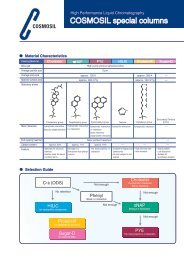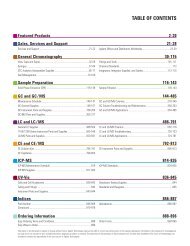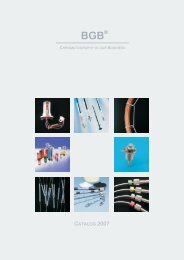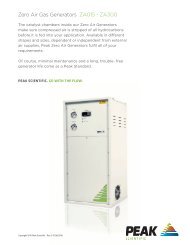Analysis of Carbaryl and Carbofuran in Drinking ... - BGB Analytik AG
Analysis of Carbaryl and Carbofuran in Drinking ... - BGB Analytik AG
Analysis of Carbaryl and Carbofuran in Drinking ... - BGB Analytik AG
You also want an ePaper? Increase the reach of your titles
YUMPU automatically turns print PDFs into web optimized ePapers that Google loves.
Results <strong>and</strong> Discussion<br />
Separation<br />
The st<strong>and</strong>ard solutions were analyzed by <strong>in</strong>ject<strong>in</strong>g 10 µL <strong>of</strong><br />
each <strong>of</strong> the st<strong>and</strong>ard solutions onto the Agilent TC-C18(2)<br />
column. The chromatograms from the st<strong>and</strong>ard <strong>in</strong>jections<br />
(Figure 3) show high performance, high resolution, <strong>and</strong> symmetrical<br />
peaks. We have also run this on an HC-C18(2) column.<br />
A little longer retention was achieved with almost the<br />
same performance as with the TC-C18(2) column. These<br />
columns have a different carbon load: 17 percent for the<br />
HC-C18(2) column <strong>and</strong> 12 percent for the TC-C18(2) column.<br />
These differences impact retention, with the HC-C18(2) column<br />
typically reta<strong>in</strong><strong>in</strong>g nonpolar <strong>and</strong> moderately polar compounds<br />
more when compared with the TC-C18(2) column. We<br />
prefer the column provid<strong>in</strong>g a shorter analysis time but resolv<strong>in</strong>g<br />
all the peaks. Although both columns are suitable for this<br />
method, we chose the TC-C18(2) because it provided a slightly<br />
shorter analysis time.<br />
LU<br />
4.5<br />
4.0<br />
3.5<br />
3.0<br />
2.5<br />
2.0<br />
1.5<br />
1.0<br />
0.5<br />
Carb<strong>of</strong>uran<br />
4.88 ng<br />
<strong>Carbaryl</strong><br />
6.0 ng<br />
0 2 4 6 8 10 12<br />
Figure 3. Chromatogram <strong>of</strong> carb<strong>of</strong>uran <strong>and</strong> carbaryl st<strong>and</strong>ards on Agilent TC-C18(2),<br />
4.6 × 150 mm, 5 µm columns.<br />
L<strong>in</strong>earity, Reproducibility, <strong>and</strong> Limit <strong>of</strong> Detection<br />
The calibration curves result<strong>in</strong>g from these st<strong>and</strong>ard <strong>in</strong>jections<br />
on the TC-C18(2) column are shown <strong>in</strong> Figure 4. The<br />
method shows excellent l<strong>in</strong>earity, be<strong>in</strong>g very close to 1.0<br />
(0.9997). To evaluate the reproducibility <strong>of</strong> this method on the<br />
TC-C18(2) column, two concentrations <strong>of</strong> carb<strong>of</strong>uran <strong>and</strong> carbaryl<br />
were each <strong>in</strong>jected 10 times. The reproducibility <strong>of</strong> the<br />
peak areas is shown <strong>in</strong> Table 2; the absolute peak area reproducibility<br />
is superior. The average relative st<strong>and</strong>ard deviation<br />
(RSD) is below 3 percent. We calculate the LOD from the<br />
level 1 st<strong>and</strong>ard with a signal-to-noise ratio <strong>of</strong> 3. The LOD is<br />
0.066 ng for carb<strong>of</strong>uran <strong>and</strong> 0.080 ng for carbaryl, which is<br />
three to four times better than the 0.25 ng that is regulated by<br />
Ch<strong>in</strong>a's dr<strong>in</strong>k<strong>in</strong>g water st<strong>and</strong>ard.<br />
m<strong>in</strong><br />
4<br />
Area<br />
80<br />
60<br />
40<br />
20<br />
0<br />
Area<br />
70<br />
60<br />
50<br />
40<br />
30<br />
20<br />
10<br />
0<br />
0<br />
0<br />
1 2<br />
1 2<br />
Carb<strong>of</strong>uran, FLD1 A<br />
Area = 7.38558201*Amt + 0<br />
Rel. Res%(4): 3.286<br />
3<br />
5<br />
Amount[ng]<br />
<strong>Carbaryl</strong>, FLD1 A<br />
Area = 6.73870683*Amt + 0<br />
Rel. Res%(1): _ 3.824<br />
3<br />
Table 2. Reproducibility <strong>of</strong> St<strong>and</strong>ards Injections<br />
4<br />
4<br />
10<br />
5<br />
Correlation: 0.99975<br />
5 10<br />
Amount[ng]<br />
5<br />
Correlation: 0.99974<br />
Figure 4. Calibration curves <strong>of</strong> carb<strong>of</strong>uran <strong>and</strong> carbaryl [Agilent TC-C18(2),<br />
4.6 × 150 mm, 5 µm columns].<br />
RSD (%) n = 10 RSD (%) n = 10<br />
Carb<strong>of</strong>uran 48.8 ppb Carb<strong>of</strong>uran 488 ppb<br />
Analyte <strong>Carbaryl</strong> 60.0 ppb <strong>Carbaryl</strong> 600 ppb<br />
Carb<strong>of</strong>uran 2.3 1.6<br />
<strong>Carbaryl</strong> 1.8 1.5<br />
Recovery<br />
Two different levels were spiked <strong>in</strong> reagent water <strong>and</strong> tap<br />
water, respectively, <strong>and</strong> then followed the sample preparation<br />
procedure. The recovery data are good, with a typical recovery<br />
<strong>in</strong> the range <strong>of</strong> 80 to 110 percent (Table 3).<br />
To better match the Ch<strong>in</strong>a dr<strong>in</strong>k<strong>in</strong>g water method, <strong>in</strong> which<br />
dichloromethane is used for liquid-liquid extraction, we chose<br />
dichloromethane as the SPE cartridge eluent. That provided us<br />
clean chromatograms.






